Today was a little later start, which was nice. We also had a change in the weather. So far, the weather has been dry and 50-60 degree weather. Today was in the 40s with rain all day. It was perfect. Perfect? Yes, perfect.
We started by entering the Old City via the Damascus Gate. I was really surprised by what I saw. I had a mental image of some sort of historical city with an ancient feel. Perhaps a tiny bit like Williamsburg in the USA is for Colonial History. What we saw was nothing like that at all. There are 1500 shops in this relatively small space. Storefront after storefront of mostly tourist junk, and most of it exactly the same as the store three doors away. A little while later, we left this particular shopping area and were in the Islamic quarter of the Old City. You can see graffiti on the walls left by Muslim pilgrims who made their way to Jerusalem.




Our objective was not shopping this morning. We were on our way to the first stop of the Via Dolorosa – the Way of the Cross. The Via Dolorosa is a path between the Antonia fortress and Golgotha that recalls the path Jesus Christ took carrying the cross on the way to His crucifixion and death. This custom of retracing Jesus’ steps to Golgotha began in the early centuries of Christianity and is still practiced today as a way to meditate on the passion, death, and resurrection of Jesus. There are 14 “stations” or stops along the way. At each station, a specific part of the Gospel narrative of His passion is read and reflected on before resuming and going to the next station. Stations 10 though 14 are located within the Church of the Holy Sepulchre, which is a church built over top of the area encompassing Golgatha and the tomb of Jesus. The Via Dolorosa is an act of prayer. The cold rainy day set the stage perfectly and somberly for remembering the passion of Jesus, who died after walking through the streets of Jerusalem.
The first station is at the Church of the Flagellation, which recalls the scouring of Jesus. We stopped here and read the first station and picked up the cross. We took turns throughout the whole Via Dolorosa carrying the cross. Every pilgrim in our group had at least one turn carrying the cross.





After walking a little, we took a stop along the way to visit the Convent of the Sisters of Notre-Dame de Sion near the east end of the Via Dolorosa. This convent building has access to some very important archeological areas under the streets of modern-day Jerusalem.
Jerusalem has been destroyed and rebuilt several times. Each time, the new city is built upon the rubble of the prior city. In some cases, buildings will share a part of the previous foundation (I’ll have an example below). In other cases, the rubble is filled in and buildings start from the top of the rubble. As it stands today, the streets of this part of Jerusalem are about 20 feet above the level the streets were at during the time of Christ. From inside the convent, you can access stairs that take you down to the previous street level as well as some ancient cisterns that were part of the water system for ancient Jerusalem.
I learned something new about how the Romans treated prisoners at this site that was fascinating to me. Down in this ruins, you can see the inscriptions in the floor for a dice-game that was played by Roman prison guards. (There is a description in the picture below, and a picture of a lit box around the area on the floor where they found an example of the inscription). What would happen is that the guards would play a dice game that would make a condemned death-row prisoner “King for a Day”. At the end of that day, he would be killed. Recall that they threw dice for Jesus’ garments and He was mocked as King.





Our destination was the Church of the Holy Sepulchre, which is built over the site of Jesus’ crucifixion and tomb. This church is co-operated by 6 different Christian sects/denominations: Greek Orthodox, Armenian Apostolic, Roman Catholic, Coptic orthodox, Syriac Orthodox, and Ethiopian Tewahedo. They often don’t agree on things, which seems to have left the church in a less-than-ideal condition. One might expect that the holiest places on earth, the very site of our redemption, would be a grand basilica, beautiful, and stately. Nope, it is certainly a very large church, but not as stately as most of the churches in Rome.
In the early years of Christianity, Jesus’ cave tomb was a popular place for Christians to pilgrim to. In order to stop this, Roman Emperor Hadrian built a pagan temple upon the ruins to bury the tomb of Jesus. During the reign of Constantine, the Emperor ordered that the temple be removed and that the cave’s rock-face be removed to expose the tomb without destroying it.
The original church was built by St. Helen (mother of Constantine) in 335. It was burned down in 614 during a Persian invasion of Jerusalem. It was rebuilt around 630, but was destroyed in 1009 by a Muslim caliph. The church was rebuilt in 1048.
If you look in the picture below, you will notice a cypress ladder up on the second floor by the windows. It is known as the “Immovable Ladder”. Its story is both funny and sad. It is first mentioned in the mid 1800s and it has remained in that location since. It’s origins come from the inability of the six Christian orders in the site to work together. It is “immovable” because there is an agreement among these orders that nothing in the church may be moved, rearranged, or altered without the consent of the other five orders. This ladder is symbolic: it’s just a ladder. But it shows that we have a long way to go on bridging the divide among our brothers and sisters in faith. Under an order of Pope Paul VI in 1964, this ladder is to remain in place until the Catholic and Orthodox Church reach a state of ecumenism.
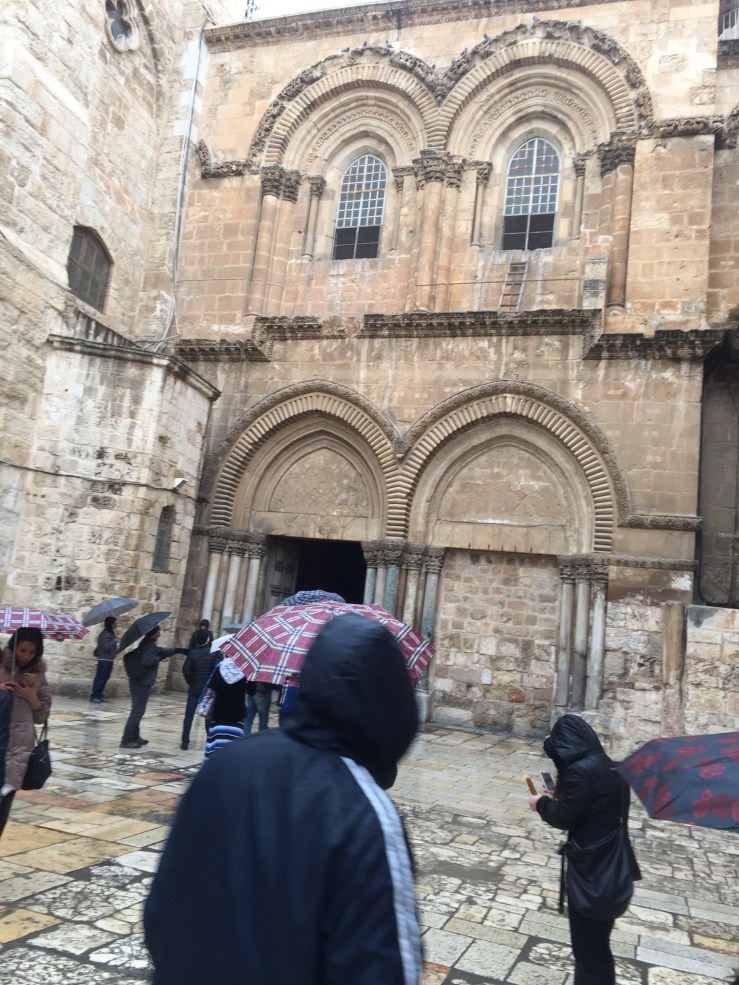
Walking in the door, the first thing you see is a slab of marble. This is said to be the place where Christ’s body was taken off of the cross and laid during burial preparation.

Next, we stood in line to enter the tomb place of Jesus. Recall earlier that this was originally a cave but Constantine had it excavated to expose the area. After the excavation, a small rotunda built of marble was built around it, called the Anastasis, which means “Resurrection” in Greek. The rock where Jesus lay was also covered by marble to protect it from anyone wishing to do it harm, especially the invading Ottomans.
After about a 25 minute wait, we took our turn to enter the tomb. During our wait, we prayed with each other and prepared to be in the holiest place on earth. It was somewhat surreal as we entered into the tomb – “are we really here?” I was expecting a little emotion, but as I knelt down and kissed the marble slab covering this place, I instantly began choking up and crying. It was very powerful.


In the gospels, we hear that the tomb was “close at hand”. It was pretty amazing to see just how close it really is. Just a few steps away from the tomb, you climb a staircase that takes you to the top of Golgatha. The rock of the hill was covered by a marble floor so when you walk up, you aren’t really aware that you’re on top of a hill. There are a few places where you can see the rock itself.
We stood in line for about another 30 minutes to get to the place where Jesus’ cross was put into the ground. Once you get there, you go under the altar and put your hand into a hole in the floor and touch the rock where the cross was. That was pretty amazing. Beneath this altar, you can also go into a room below that is at “the foot of the cross”. There is a glass window in the wall where can see a crack in the rock that is said to be caused by the earthquake that happened after Jesus’ death. Many people, including me, brought prayer petitions and left them there. I’ve been carrying prayers for many people in my pocket since I left Lexington. I left my petitions and those entrusted to me at the foot of the cross. Felt good to do that: the burdens of my life were lifted and I helped carry some others’ burdens for them.

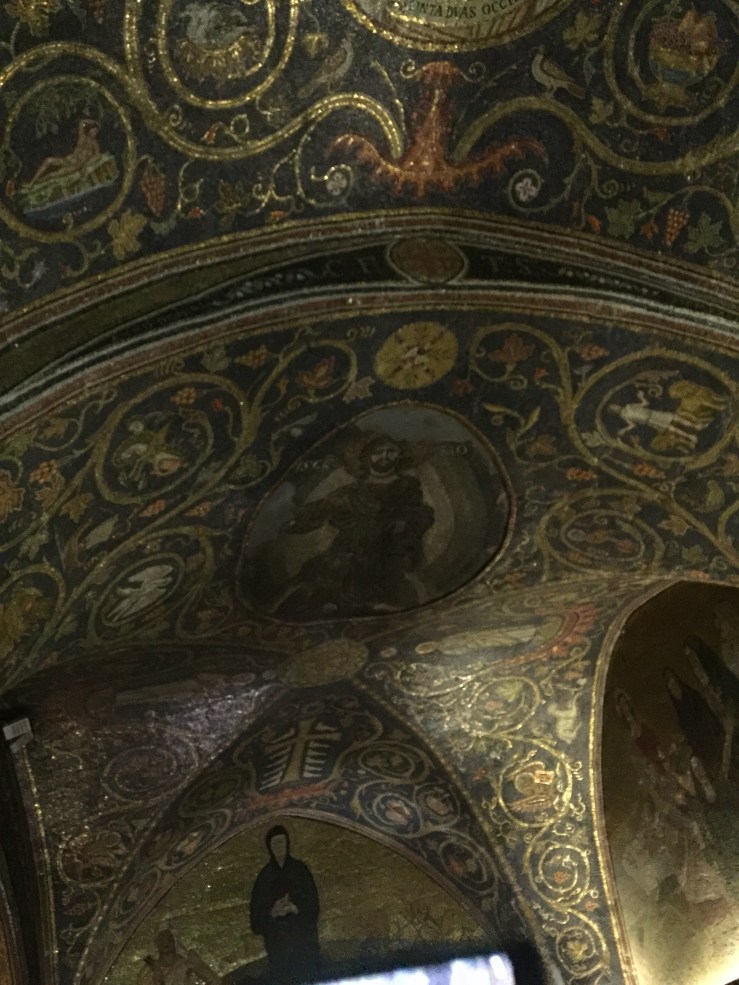
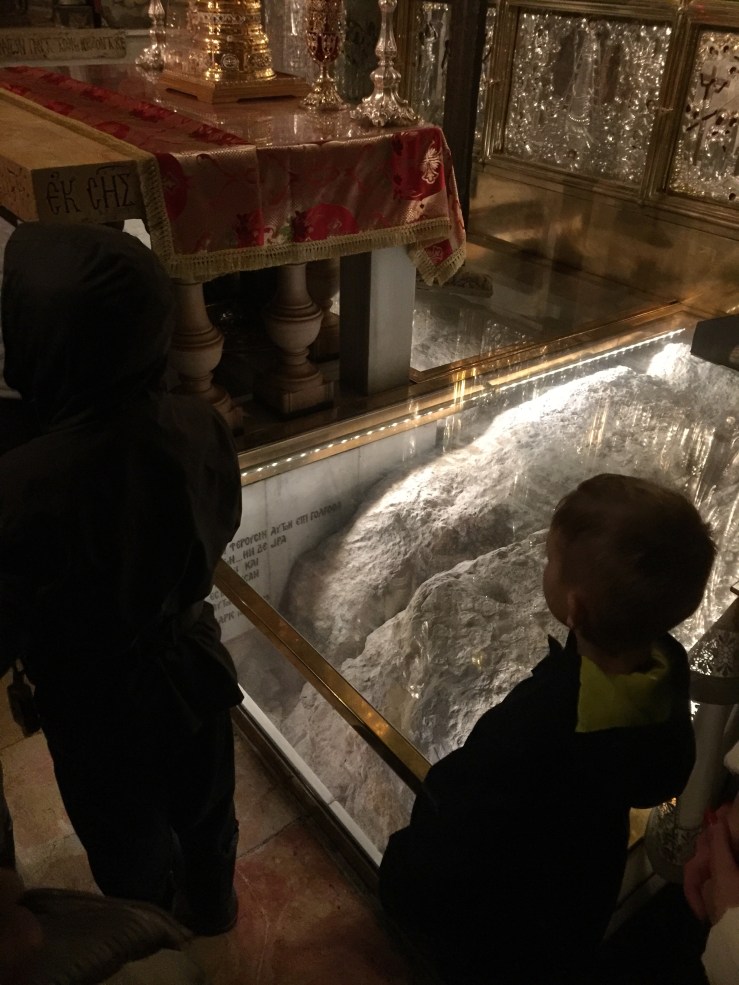



Next stop was to go down some stairs to the bottom of the rock quarry known as Golgotha. As we descended the steps, you can see crosses carved in the wall. These are “12th C graffiti” from pilgrims who made the journey to these sacred places.
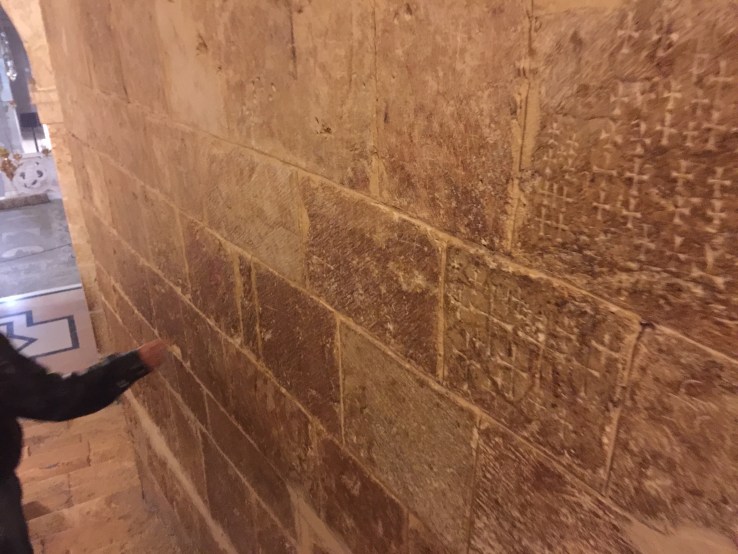


After a quick lunch, we ventured onward to an Orthodox convent that has a remnant of the original wall of Jerusalem. Note that Jesus was crucified outside of the walls of Jerusalem. At His time, Golgatha would have been outside this wall, even though it is within the current walls today. This particular section of the wall is known as the Judgment Gate. This is the gate that Jesus would have walked through on his way out of the city to Golgatha.
One special feature on this wall to note: you can see what is called the “Eye of the Needle”. This was an opening in the wall that was too big for a pack animal to pass, but a person could fit through. When Jesus says that a camel can not fit through the eye of a needle, here’s likely what he was referring to.




The eye of the needle is a few feet left of the bottom of the archway in this picture above. I stood next to it for scale in the picture below.



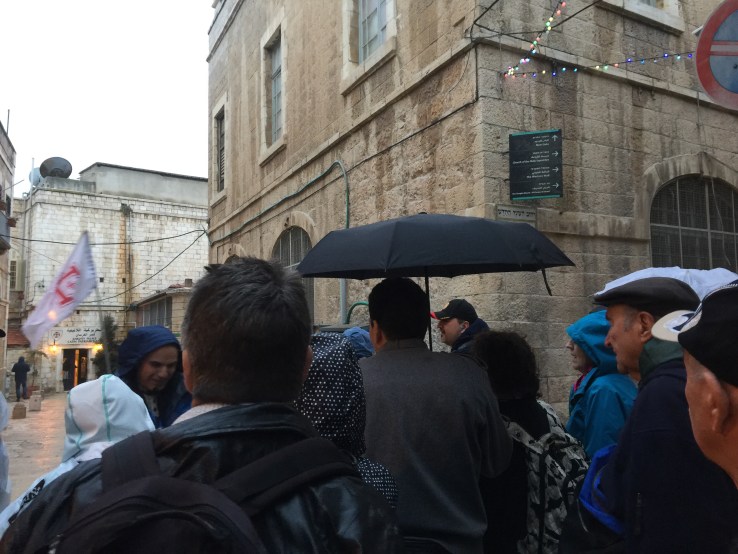
A short while later, we were back at our hotel. A quick dinner was followed by some very enjoyable conversation with the pilgrims from my parish over a bottle of wine. We talked about the pilgrimage in general and more specifically about today’s part of the pilgrimage.
I’ve been writing this blog for a few reasons. First is for my family. Second is for myself so that I don’t forget. Third is for others who could not afford to come on the pilgrimage themselves so that they might experience at least some of the pilgrimage.
In closing tonight, I want to reflect on one important thing: the resurrection. We can look at the tomb of Christ as the end. We can say that this is where He died. There’s nothing incorrect about that except that it is NOT the end. It is the beginning. We must never forget that Jesus’ tomb could not contain death. That is the place of our resurrection! Death holds no sting for us. Death holds nothing at all over us. It is through the resurrection of Christ that we have eternal hope for our own resurrection.
Amen.
Peace!
– Deacon Matt
Thank you, again, Matt.
[…] Israel Day 5: Jerusalem Old City – the Via Dolorosa and the Holy Sepulchre […]